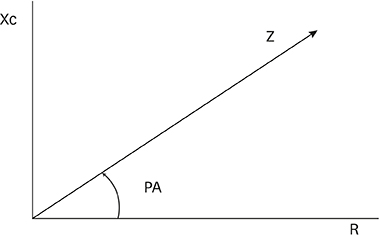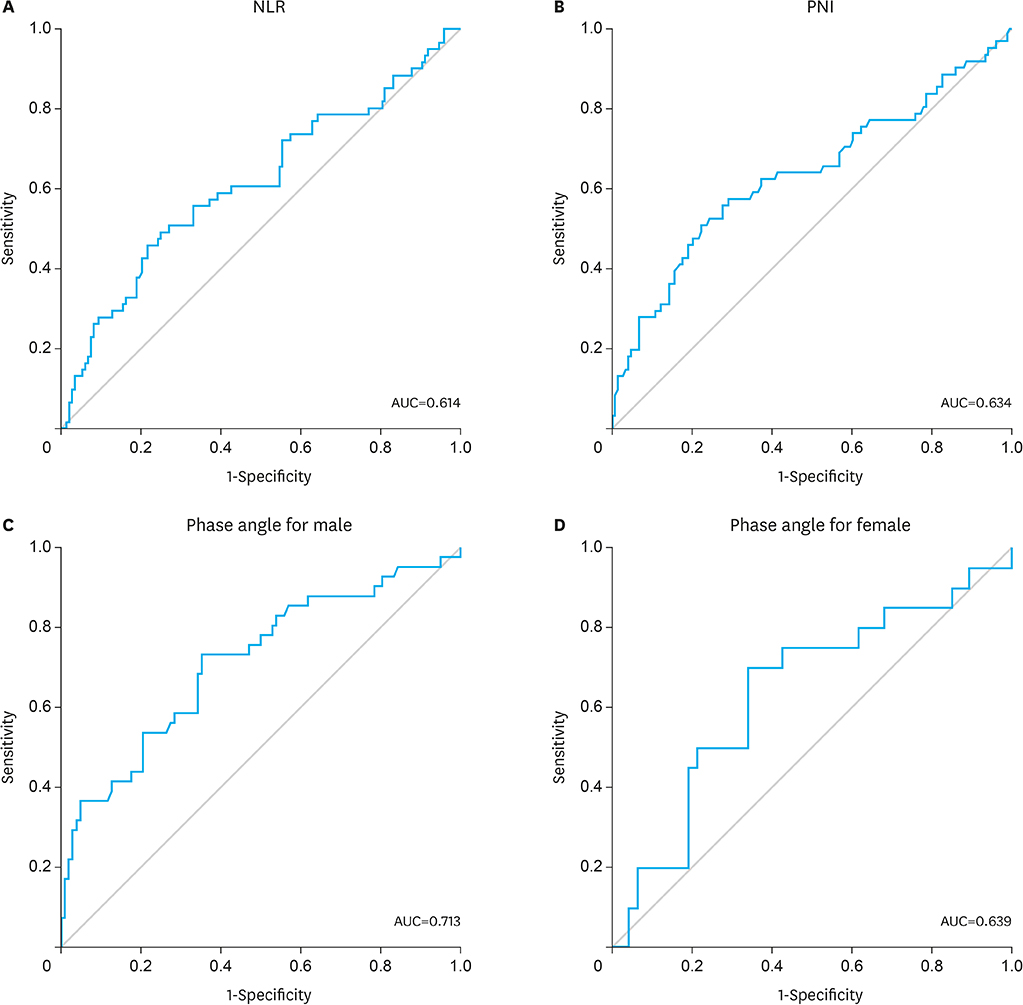J Gastric Cancer.
2019 Sep;19(3):278-289. 10.5230/jgc.2019.19.e22.
Bioelectrical Impedance Analysis for Prediction of Early Complications after Gastrectomy in Elderly Patients with Gastric Cancer: the Phase Angle Measured Using Bioelectrical Impedance Analysis
- Affiliations
-
- 1Gastric Cancer Center, Kyungpook National University Chilgok Hospital, Daegu, Korea. okugisurg@knu.ac.kr
- 2Department of Surgery, School of Medicine, Kyungpook National University, Daegu, Korea.
- 3Department of Surgery, Kyungpook National University Hospital, Daegu, Korea.
- KMID: 2458828
- DOI: http://doi.org/10.5230/jgc.2019.19.e22
Abstract
- PURPOSE
Phase angle obtained using bioelectrical impedance analysis (BIA) provides a relatively precise assessment of the nutritional status of elderly patients. This study aimed to evaluate the significance of phase angle as a risk factor for complications after gastrectomy in elderly patients.
MATERIALS AND METHODS
We evaluated 210 elderly patients (aged ≥65 years) who had undergone gastrectomy for gastric cancer between August 2016 and August 2017. The phase angle cutoff value was calculated using receiver operating characteristic curve analysis according to sex. A retrospective analysis regarding the correlation between early postoperative complications and well-known risk factors, including the phase angle, was performed.
RESULTS
Multivariate analysis revealed that the presence of two or more comorbidities (odds ratio [OR], 3.675) and hypoalbuminemia (OR, 4.059) were independent risk factors for overall complications, and female sex (OR, 2.993) was independent risk factor for severe complications. A low phase angle (OR, 2.901 and 4.348, respectively) and total gastrectomy (OR, 4.718 and 3.473, respectively) were independent risk factors for both overall and severe complications.
CONCLUSIONS
Our findings show that preoperative low phase angle predicts the risk of overall and severe complications. Our findings suggest that BIA should be performed to assess the risk of postoperative complications in elderly patients with gastric cancer.
MeSH Terms
Figure
Reference
-
1. Takeshita H, Ichikawa D, Komatsu S, Kubota T, Okamoto K, Shiozaki A, et al. Surgical outcomes of gastrectomy for elderly patients with gastric cancer. World J Surg. 2013; 37:2891–2898.
Article2. Information Committee of Korean Gastric Cancer Association. Korean Gastric Cancer Association nationwide survey on gastric cancer in 2014. J Gastric Cancer. 2016; 16:131–140.3. Polanczyk CA, Marcantonio E, Goldman L, Rohde LE, Orav J, Mangione CM, et al. Impact of age on perioperative complications and length of stay in patients undergoing noncardiac surgery. Ann Intern Med. 2001; 134:637–643.
Article4. Seiler WO. Clinical pictures of malnutrition in ill elderly subjects. Nutrition. 2001; 17:496–498.
Article5. Choi WJ, Kim J. Nutritional care of gastric cancer patients with clinical outcomes and complications: a review. Clin Nutr Res. 2016; 5:65–78.
Article6. Lohsiriwat V. The influence of preoperative nutritional status on the outcomes of an enhanced recovery after surgery (ERAS) programme for colorectal cancer surgery. Tech Coloproctol. 2014; 18:1075–1080.
Article7. Zarowitz BJ, Pilla AM. Bioelectrical impedance in clinical practice. DICP. 1989; 23:548–555.
Article8. Kyle UG, Genton L, Pichard C. Low phase angle determined by bioelectrical impedance analysis is associated with malnutrition and nutritional risk at hospital admission. Clin Nutr. 2013; 32:294–299.
Article9. Baumgartner RN, Chumlea WC, Roche AF. Bioelectric impedance phase angle and body composition. Am J Clin Nutr. 1988; 48:16–23.
Article10. Schwenk A, Beisenherz A, Römer K, Kremer G, Salzberger B, Elia M. Phase angle from bioelectrical impedance analysis remains an independent predictive marker in HIV-infected patients in the era of highly active antiretroviral treatment. Am J Clin Nutr. 2000; 72:496–501.
Article11. Selberg O, Selberg D. Norms and correlates of bioimpedance phase angle in healthy human subjects, hospitalized patients, and patients with liver cirrhosis. Eur J Appl Physiol. 2002; 86:509–516.
Article12. Kuzu MA, Terzioğlu H, Genç V, Erkek AB, Ozban M, Sonyürek P, et al. Preoperative nutritional risk assessment in predicting postoperative outcome in patients undergoing major surgery. World J Surg. 2006; 30:378–390.
Article13. Hu WH, Cajas-Monson LC, Eisenstein S, Parry L, Cosman B, Ramamoorthy S. Preoperative malnutrition assessments as predictors of postoperative mortality and morbidity in colorectal cancer: an analysis of ACS-NSQIP. Nutr J. 2015; 14:91.
Article14. Oliveira CM, Kubrusly M, Mota RS, Silva CA, Choukroun G, Oliveira VN. The phase angle and mass body cell as markers of nutritional status in hemodialysis patients. J Ren Nutr. 2010; 20:314–320.
Article15. Gupta D, Lammersfeld CA, Burrows JL, Dahlk SL, Vashi PG, Grutsch JF, et al. Bioelectrical impedance phase angle in clinical practice: implications for prognosis in advanced colorectal cancer. Am J Clin Nutr. 2004; 80:1634–1638.
Article16. Gupta D, Lis CG, Dahlk SL, Vashi PG, Grutsch JF, Lammersfeld CA. Bioelectrical impedance phase angle as a prognostic indicator in advanced pancreatic cancer. Br J Nutr. 2004; 92:957–962.
Article17. Gupta D, Lammersfeld CA, Vashi PG, King J, Dahlk SL, Grutsch JF, et al. Bioelectrical impedance phase angle as a prognostic indicator in breast cancer. BMC Cancer. 2008; 8:249.
Article18. Kim HS, Lee ES, Lee YJ, Lee JH, Lee CT, Cho YJ. Clinical application of bioelectrical impedance analysis and its phase angle for nutritional assessment of critically Ill patients. J Clin Nutr. 2015; 7:54–61.
Article19. Wirth R, Volkert D, Rösler A, Sieber CC, Bauer JM. Bioelectric impedance phase angle is associated with hospital mortality of geriatric patients. Arch Gerontol Geriatr. 2010; 51:290–294.
Article20. Clavien PA, Barkun J, de Oliveira ML, Vauthey JN, Dindo D, Schulick RD, et al. The Clavien-Dindo classification of surgical complications: five-year experience. Ann Surg. 2009; 250:187–196.21. Lee KG, Lee HJ, Yang JY, Oh SY, Bard S, Suh YS, et al. Risk factors associated with complication following gastrectomy for gastric cancer: retrospective analysis of prospectively collected data based on the Clavien-Dindo system. J Gastrointest Surg. 2014; 18:1269–1277.
Article22. Kang SC, Kim HI, Kim MG. Low serum albumin level, male sex, and total gastrectomy are risk factors of severe postoperative complications in elderly gastric cancer patients. J Gastric Cancer. 2016; 16:43–50.
Article23. Hamakawa T, Kurokawa Y, Mikami J, Miyazaki Y, Takahashi T, Yamasaki M, et al. Risk factors for postoperative complications after gastrectomy in gastric cancer patients with comorbidities. Surg Today. 2016; 46:224–228.
Article24. Seo SH, Hur H, An CW, Yi X, Kim JY, Han SU, et al. Operative risk factors in gastric cancer surgery for elderly patients. J Gastric Cancer. 2011; 11:116–121.
Article25. Nagano M, Suita S, Yamanouchi T. The validity of bioelectrical impedance phase angle for nutritional assessment in children. J Pediatr Surg. 2000; 35:1035–1039.
Article26. Araujo Antunes A, Alves Pereira Rodrigues AP, Geraix J, Vaz de Arruda Silveira L, Câmara Marques Pereira P, Barros Leite Carvalhaes MA. Nutritional assessment of hospitalized HIV-infected patients by the phase angle z-score measurement. Nutr Hosp. 2012; 27:771–774.27. Wilhelm-Leen ER, Hall YN, Horwitz RI, Chertow GM. Phase angle, frailty and mortality in older adults. J Gen Intern Med. 2014; 29:147–154.
Article28. Grundmann O, Yoon SL, Williams JJ. The value of bioelectrical impedance analysis and phase angle in the evaluation of malnutrition and quality of life in cancer patients--a comprehensive review. Eur J Clin Nutr. 2015; 69:1290–1297.
Article29. Varan HD, Bolayir B, Kara O, Arik G, Kizilarslanoglu MC, Kilic MK, et al. Phase angle assessment by bioelectrical impedance analysis and its predictive value for malnutrition risk in hospitalized geriatric patients. Aging Clin Exp Res. 2016; 28:1121–1126.
Article30. Sungurtekin H, Sungurtekin U, Balci C, Zencir M, Erdem E. The influence of nutritional status on complications after major intraabdominal surgery. J Am Coll Nutr. 2004; 23:227–232.
Article31. Schiesser M, Müller S, Kirchhoff P, Breitenstein S, Schäfer M, Clavien PA. Assessment of a novel screening score for nutritional risk in predicting complications in gastro-intestinal surgery. Clin Nutr. 2008; 27:565–570.
Article32. Tokunaga M, Tanizawa Y, Bando E, Kawamura T, Terashima M. Poor survival rate in patients with postoperative intra-abdominal infectious complications following curative gastrectomy for gastric cancer. Ann Surg Oncol. 2013; 20:1575–1583.
Article33. Barbosa-Silva MC, Barros AJ, Wang J, Heymsfield SB, Pierson RN Jr. Bioelectrical impedance analysis: population reference values for phase angle by age and sex. Am J Clin Nutr. 2005; 82:49–52.
Article34. Bosy-Westphal A, Danielzik S, Dörhöfer RP, Later W, Wiese S, Müller MJ. Phase angle from bioelectrical impedance analysis: population reference values by age, sex, and body mass index. JPEN J Parenter Enteral Nutr. 2006; 30:309–316.
Article
- Full Text Links
- Actions
-
Cited
- CITED
-
- Close
- Share
- Similar articles
-
- Changes in Body Composition after a Radical Gastrectomy for a Gastric Adenocarcinoma using Bioelectrical Impedance Analysis during the First Year following Surgery
- Percent of Body Fat by Bioelectrical Impedance Analysis in Healthy Children
- The Clinical Significance of Bioelectrical Impedance Analysis for The Diagnosis of Obesity on Elementary Students
- Association between bioelectrical impedance analysis and platelet-to-lymphocyte ratio in colorectal cancer
- Significance of Bioelectrical Impedance during Ischemia-Reperfusion Injury in the Rabbit's Liver



